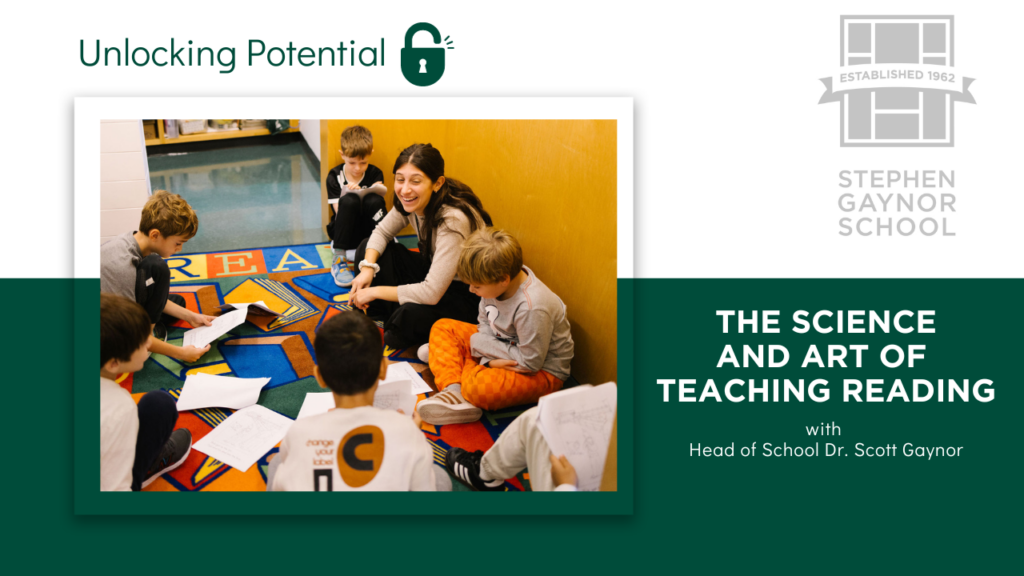
by Dr. Scott Gaynor, Head of School
Seeing a child curled up with a book as they independently learn to read the words and find the meaning in a story is a heartwarming image. We have been taught that learning to read is akin to learning to talk – if children are exposed to the pictures and words often enough, they will learn to read. But, findings from thousands of research studies over the past two decades indicate that this magical transformation is inaccurate. In the battle over the best reading program, the pendulum has swung dramatically in favor of the science of reading. Headlines have celebrated the end of balanced literacy in favor of the evidenced-based phonemic approach. Columbia University’s Teachers College recently parted ways with Lucy Calkins’ Reading and Writing Workshop. Under New York City’s current mayor, city schools are beginning to implement a new phonics-based reading curriculum. Across the country, dozens of school districts have followed suit and embraced the science of reading over the balanced literacy method. But this is merely the first step in giving our teachers the tools they need to build independent, confident readers.
As the head of a school for children with learning differences, I know first hand how detrimental reading challenges can be. Many students come to our school at an age at which they should be fluent readers, but struggle to read even at the basic level. I also know that when teachers feel confident in the instructional methods, they are best equipped to address the varying needs of the children. The reading wars have brought to light what my colleagues in special education have long known and applied in our schools, that reading instruction must be structured, systematic, backed by science, and fun.
At my school, our reading instruction is steeped in the evidence-based approach of Orton-Gillingham (OG), the founders of modern-day phonics. A great deal of criticism has targeted phonics’ explicit, systematic and sequential approach as a boring way to learn to read. The idea that teaching phonics instead of balanced literacy has to be tedious and mundane is a misleading accusation. This is why we marry the art of instruction with the well-proven science of phonics instruction.
The art of teaching requires the teacher to see the child at the center of the curriculum. If you walked into an OG-based lesson at our school you would see children enthusiastically and actively engaged in their learning. Whether they are learning sound cards or tapping out the individual sounds of a word, students are active participants in the lesson. Building on each prior skill, students take great pride in moving from the individual sounds to whole words to reading full sentences. Mastery of these skills builds confident readers who are able to find meaning in the text and a love of literature. Well trained teachers can unlock these skills.
Before we begin this new reading journey, we need to understand that selecting a curriculum is only one aspect of good reading instruction. We are asking teachers to make this titanic shift and to learn new methodologies and skills on the go. It is no shock that this change is being met with frustration, anxiety, and even resistance from some teachers and parents. Teachers who are so overwhelmed by implementing new strategies that they lose sight of the joys of teaching reading, would be yet another casualty of the reading wars. We must make sure not to lose the excitement teachers create in their classrooms during reading lessons. They bring the instruction to life, engage our students, and infuse the joy of reading into our young learners. The science of reading is the approach, but the art is the relationship between the teacher, the lesson, and the child. When teachers are comfortable with the material, they emanate joy and spark student learning.
Teachers need time outside the classroom for professional development as well as experienced supervision in the classroom to learn and implement the new approach. School districts need the resources to offer expertly-led professional development sessions, and teachers need time to devote to developing their new skills. Future generations would benefit greatly if graduate schools of education updated their curricula to include explicit training in the science of reading so that teachers have the requisite skills they need when they graduate.
I believe teachers can solve our reading crisis, but we need to give them grace, time, and the resources to make this shift to the science of reading. Teachers need to be fully trained and skilled in the instructional methods, so that they can have the confidence and capacity to continue to bring joy to their lessons. If we are truly committed to the science of reading, we need to make sure there is still room for it to partner with the art of teaching.
This article is the first posting from Stephen Gaynor School’s new LinkedIn newsletter, Unlocking Potential. To be alerted to future editions of our newsletter on LinkedIn, please click the button below!
